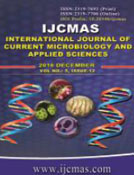


 National Academy of Agricultural Sciences (NAAS)
National Academy of Agricultural Sciences (NAAS)

|
PRINT ISSN : 2319-7692
Online ISSN : 2319-7706 Issues : 12 per year Publisher : Excellent Publishers Email : editorijcmas@gmail.com / submit@ijcmas.com Editor-in-chief: Dr.M.Prakash Index Copernicus ICV 2018: 95.39 NAAS RATING 2020: 5.38 |
The present study is an analysis of a retrospective data gathered in Chennai in 2005, in order to compare the bacteriological profiles revealed in Chennai, with the bacteriological profiles reported by other investigators from various other locations in India, as reported in the literature, with a view to incorporate the lessons learnt, for the benefit of future–studies on topics of diabetic foot ulcers. The retrospective study was related to 75 patients receiving treatment for diabetic foot ulcers, in a tertiary health care centre in Chennai City, India, during a period of 5-months from May to September 2005. The patients were screened for bacterial pathogens in their wounds. A total of 104 isolates were obtained. In the microbiological analysis carried out as per standard procedures, the pathogens were identified as i) Escherichia coli (22.2%), ii) Staphylococcus aureus(17.3%), iii) Pseudomonas aeruginosa (17.3 %), iv) Klebsiella species (10.6%), v) Coagulase Negative Staphylococcus (CONS) species (10.6 %), vi)Proteus species (9.6 %), vii) Streptococcus species ( 5.8 % ), viii) Corynebacterium species (3.8%),and ix) Enterococcus species (2.9%). This result was compared with similar findings of 17-other Investigators in India (8-from South India and 9-from North India), as obtained in the literature review. This random comparison has been useful to realize the reality that the pathogens found in diabetic foot ulcers could include bacteria (aerobes, anaerobes and facultative-anaerobes) and fungal organisms. This implies that there is a need to carry out the antimicrobial sensitivity tests for all categories of pathogens present in the wound. Considering the potential risk of a trivial injury in diabetic patients getting slowly and surely converted into more serious complications, it may be concluded that all classes of pathogens need to be examined, thoroughly, in the Clinical Microbiology Laboratory attached to each District Headquarters Hospital of the Government, in order to augment the efforts of Clinicians in selecting the appropriate therapies needed for the diabetic foot ulcer patients who, mostly, happen to be hailing from the rural India. No pathogen needs to be ignored or spared!
 |
 |
 |
 |
 |